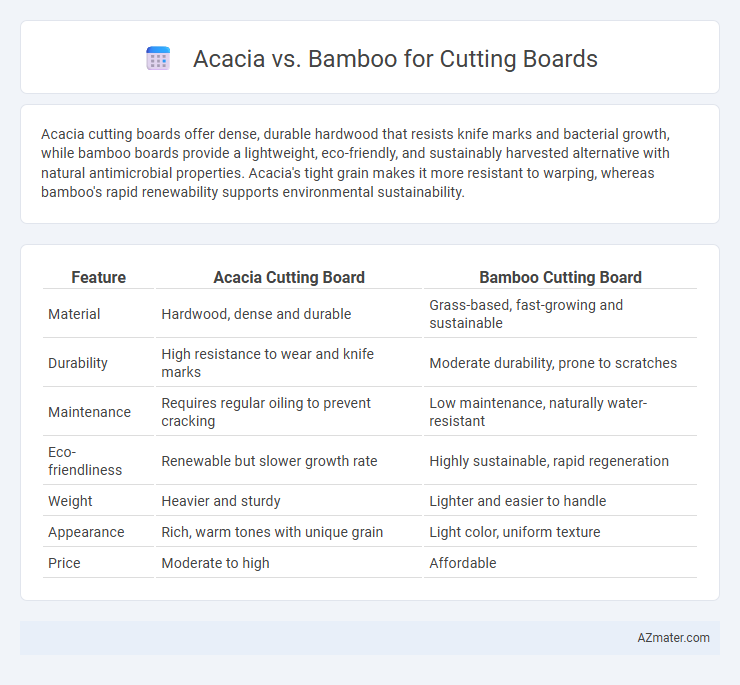Acacia cutting boards offer dense, durable hardwood that resists knife marks and bacterial growth, while bamboo boards provide a lightweight, eco-friendly, and sustainably harvested alternative with natural antimicrobial properties. Acacia's tight grain makes it more resistant to warping, whereas bamboo's rapid renewability supports environmental sustainability.
Table of Comparison
| Feature | Acacia Cutting Board | Bamboo Cutting Board |
|---|---|---|
| Material | Hardwood, dense and durable | Grass-based, fast-growing and sustainable |
| Durability | High resistance to wear and knife marks | Moderate durability, prone to scratches |
| Maintenance | Requires regular oiling to prevent cracking | Low maintenance, naturally water-resistant |
| Eco-friendliness | Renewable but slower growth rate | Highly sustainable, rapid regeneration |
| Weight | Heavier and sturdy | Lighter and easier to handle |
| Appearance | Rich, warm tones with unique grain | Light color, uniform texture |
| Price | Moderate to high | Affordable |
Overview: Acacia vs Bamboo Cutting Boards
Acacia cutting boards are prized for their rich, warm hues and dense hardwood structure, offering excellent durability and natural resistance to moisture and bacteria. Bamboo cutting boards provide a lightweight, eco-friendly alternative with rapid renewability and a hard surface that resists knife marks and warping. Both materials excel in sustainability and maintenance, but Acacia's natural oils enhance its longevity, while Bamboo's fast growth cycle supports environmental conservation.
Material Composition and Sourcing
Acacia cutting boards are crafted from dense hardwood with a natural resistance to moisture and bacteria, sourced primarily from sustainably managed forests in Australia and Southeast Asia. Bamboo boards consist of fast-growing grasses that are laminated together, offering a lightweight yet durable surface, typically harvested from renewable plantations in China. Both materials highlight eco-friendly sourcing, but bamboo's rapid regrowth rate and hardness make it a highly sustainable alternative to traditional hardwoods like acacia.
Durability and Longevity Comparison
Acacia cutting boards offer exceptional durability due to their dense hardwood structure, which resists scratches and knife marks effectively. Bamboo boards boast natural hardness and moisture resistance, enhancing their longevity by preventing warping and cracking over time. While both materials are sturdy, acacia typically outperforms bamboo in long-term wear resistance, making it a preferred choice for heavy-duty kitchen use.
Knife Friendliness and Surface Integrity
Acacia cutting boards are known for their moderate hardness, providing a balance between durability and knife friendliness by minimizing blade dulling. Bamboo boards, being harder and more brittle, can wear down knives more quickly, though their dense grain offers strong surface integrity and resistance to scratches. Both materials maintain good antibacterial properties, but acacia's slightly softer surface tends to preserve knife edges better over time.
Maintenance and Cleaning Requirements
Acacia cutting boards require regular oiling with mineral oil to prevent drying and cracking, and should be hand-washed with mild soap and water to maintain their durability. Bamboo cutting boards are naturally antimicrobial and less porous, making them easier to clean, but they still need to be dried thoroughly to avoid warping. Both materials should be kept away from prolonged water exposure and never placed in the dishwasher to ensure long-lasting performance.
Eco-Friendliness and Sustainability
Acacia and bamboo are both popular materials for eco-friendly cutting boards, with bamboo recognized for its rapid growth, regenerating fully in three to five years, making it highly renewable and sustainable. Acacia, a hardwood, grows slower but is often sourced from managed forests, offering durability with a lower environmental impact when responsibly harvested. Bamboo's natural resistance to bacteria and minimal need for pesticides further enhances its sustainability compared to acacia, which may require more intensive cultivation practices.
Aesthetic Appeal and Design Options
Acacia cutting boards feature rich, warm tones with intricate grain patterns that create a classic, rustic aesthetic ideal for traditional kitchens, while bamboo boards offer a sleek, modern look with uniform light color and fine texture suitable for minimalist designs. Acacia's natural oil content enhances durability and adds a subtle sheen, making each board uniquely attractive, whereas bamboo's eco-friendly appeal comes from its sustainable growth and smooth, consistent surface that resists scratches. Both materials provide versatile design options, but acacia excels in decorative edge profiles and varied wood knots, giving each cutting board a distinctive, handcrafted charm compared to bamboo's uniform and streamlined appearance.
Cost and Value for Money
Acacia cutting boards typically offer a lower price point compared to bamboo, delivering durable hardwood quality that balances cost and longevity. Bamboo boards provide excellent value for money through their fast-growing, sustainable nature and natural resistance to moisture and bacteria, often appealing to eco-conscious buyers. While acacia excels in hardness and rich aesthetics, bamboo's affordability and eco-friendly properties make it a cost-effective choice for everyday kitchen use.
Health and Safety Considerations
Acacia cutting boards are naturally antimicrobial due to their dense grain, reducing bacterial growth and enhancing food safety. Bamboo boards, being harder and less porous, resist knife scars and bacterial penetration but may splinter if poorly maintained. Both materials require regular oiling to prevent cracking and to maintain their hygienic properties.
Choosing the Right Cutting Board: Acacia or Bamboo?
Acacia cutting boards offer a dense, durable surface with natural water resistance and rich, warm tones that resist knife marks and bacteria growth, making them ideal for heavy-duty kitchen tasks. Bamboo boards provide a lightweight, eco-friendly option, featuring rapid renewability and a harder surface that resists scratches and moisture but may require more maintenance to prevent cracking. Selecting the right cutting board depends on factors like durability, maintenance preference, and environmental impact, with acacia favored for toughness and aesthetics, while bamboo excels in sustainability and ease of cleaning.

Infographic: Acacia vs Bamboo for Cutting Board
 azmater.com
azmater.com